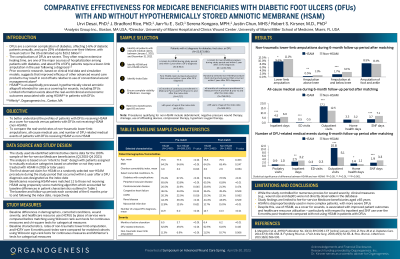Clinical Research
(CR-014) Comparative Effectiveness Analyses for Medicare Beneficiaries with Diabetic Foot Ulcers Treated With and Without Hypothermically Stored Amniotic Membrane (HSAM)
Friday, April 28, 2023
7:15 PM - 8:30 PM East Coast USA Time

Justin Chun, MHS; Jian-Yu e, ScD; Robert Kirsner, MD, PhD; Serena Kongara, MPH; Bradford Rice, PhD
Introduction: Hypothermically stored amniotic membrane (HSAM)* is intended for use as a placental allograft wound covering for the management of acute and chronic wounds including diabetic foot ulcers (DFUs). However, there is limited information about the real-world clinical and economic outcomes associated with using HSAM* for people with DFUs.
Methods: The 100% Medicare Fee-For-Service data in Standard Analytic File (Q1 2015-Q4 2021) were used to identify two mutually-exclusive cohorts of beneficiaries with DFUs: (i) beneficiaries who received HSAM* (first claim considered as index date), and (ii) beneficiaries who received advanced wound care (e.g., debridement, offloading, negative pressure wound therapy) but not HSAM* (index date selected at random). Beneficiaries were required to have continuous enrollment in Medicare Parts A and B at least 6 months before and after the index date. Beneficiaries receiving HSAM* were matched 1:1 to those not receiving HSAM* using propensity score matching. Outcomes over 6 months post-index were compared between matched cohorts using statistical tests for paired data. Standardized difference (SD) >10% and p-values < 0.05 were considered statistically significant.
Results: Among all beneficiaries meeting the selection criteria, 3,499 received HSAM* and 589,330 did not receive HSAM*. Compared to beneficiaries not receiving HSAM*, those receiving HSAM* had greater disease severity before treatment initiation as indicated by longer duration of active ulceration (6.5 vs. 3.7 months), higher rates of DFU-related infections (62.8% vs. 49.1%), non-traumatic lower-limb amputations (11.3% vs. 6.9%), and higher total medical costs ($31,855.9 vs. $24.132.4). During a 6-month follow-up period, matched beneficiaries receiving HSAM* (N=3,465) had lower rates of non-traumatic lower-limb amputations (9.6% vs. 11.1%; SD = -4.64%; p = 0.05), as well as shorter stays and lower costs for hospitalization (4.5 vs. 6.0 days; $9,727.6 vs. $12,161.4) and skilled nursing facility (3.7 vs. 7.1 days; $1,634.8 vs. $2,776.8; SD >10% and p < 0.001 for all comparisons) than similar beneficiaries not receiving HSAM*.
Discussion: The study suggests that HSAM* is disproportionately used to treat more complex beneficiaries, with more severe DFUs. After adjusting for baseline differences, beneficiaries receiving HSAM* had lower rates of amputations, and costs for hospitalization and skilled nursing facility visits than those not receiving HSAM*.
Methods: The 100% Medicare Fee-For-Service data in Standard Analytic File (Q1 2015-Q4 2021) were used to identify two mutually-exclusive cohorts of beneficiaries with DFUs: (i) beneficiaries who received HSAM* (first claim considered as index date), and (ii) beneficiaries who received advanced wound care (e.g., debridement, offloading, negative pressure wound therapy) but not HSAM* (index date selected at random). Beneficiaries were required to have continuous enrollment in Medicare Parts A and B at least 6 months before and after the index date. Beneficiaries receiving HSAM* were matched 1:1 to those not receiving HSAM* using propensity score matching. Outcomes over 6 months post-index were compared between matched cohorts using statistical tests for paired data. Standardized difference (SD) >10% and p-values < 0.05 were considered statistically significant.
Results: Among all beneficiaries meeting the selection criteria, 3,499 received HSAM* and 589,330 did not receive HSAM*. Compared to beneficiaries not receiving HSAM*, those receiving HSAM* had greater disease severity before treatment initiation as indicated by longer duration of active ulceration (6.5 vs. 3.7 months), higher rates of DFU-related infections (62.8% vs. 49.1%), non-traumatic lower-limb amputations (11.3% vs. 6.9%), and higher total medical costs ($31,855.9 vs. $24.132.4). During a 6-month follow-up period, matched beneficiaries receiving HSAM* (N=3,465) had lower rates of non-traumatic lower-limb amputations (9.6% vs. 11.1%; SD = -4.64%; p = 0.05), as well as shorter stays and lower costs for hospitalization (4.5 vs. 6.0 days; $9,727.6 vs. $12,161.4) and skilled nursing facility (3.7 vs. 7.1 days; $1,634.8 vs. $2,776.8; SD >10% and p < 0.001 for all comparisons) than similar beneficiaries not receiving HSAM*.
Discussion: The study suggests that HSAM* is disproportionately used to treat more complex beneficiaries, with more severe DFUs. After adjusting for baseline differences, beneficiaries receiving HSAM* had lower rates of amputations, and costs for hospitalization and skilled nursing facility visits than those not receiving HSAM*.

.png)